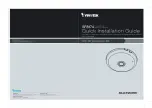
DRA-2 UNIVERSAL COMMUNICATION NODE
15/158
USER GUIDE - Rev.5 (January 2018)
1.4.7.3
MV BPLC (high speed) interface characteristics
➢
Frequency range of 2 to 30 MHz.
➢
200 Mbit/s
*
channel rate.
➢
150 Mbit/s
*
user max. rate.
➢
AES encryption of 128 bits.
➢
Flexibility in suppressing certain frequencies to prevent interference with other services.
➢
OFDM modulation with 1155 useful carriers.
➢
1024/256/64/16/8 QAM, QPSK, BPSK, ROBO modulation (DBPSK basic/robust
modulation)
– independently applied to each carrier.
➢
Output power of between 1 and 10 W
➢
Range of up to 1 km
*
.
1.4.7.4
MV SSPLC (long range) interface characteristics
➢
Frequency range of 2 to 10 MHz.
➢
128 kbit/s
†
speed.
➢
Direct-Sequence Spread Spectrum (DSSS) Modulation.
➢
Output power of between 1 and 10 W
➢
Distances up to 5 km
*
.
1.4.7.5
Cable modem characteristics
➢
Protocol support:
•
DOCSIS/EuroDOCSIS 1.0/1.1/2.0
•
SNMP v1, v2c, v3
➢
Connector: F-type female 75
Ω RF
➢
Receiver
•
Demodulation: 64/256 QAM
•
Maximum speed: 38 Mbit/s (64 QAM) / 43 Mbit/s (256 QAM) DOCSIS
•
Frequency range: 108 ÷ 860 MHz (EuroDOCSIS)
•
Signal level: -13 ÷ 17 dBmV (EuroDOCSIS)
•
Input return loss: >6 dB EuroDOCSIS (108 ÷ 860 MHz)
*
There is a trade-off between transmission rate, distance and SNR needed in the receiver.
†
There is a trade-off between transmission rate, distance and SNR needed in the receiver.
















































